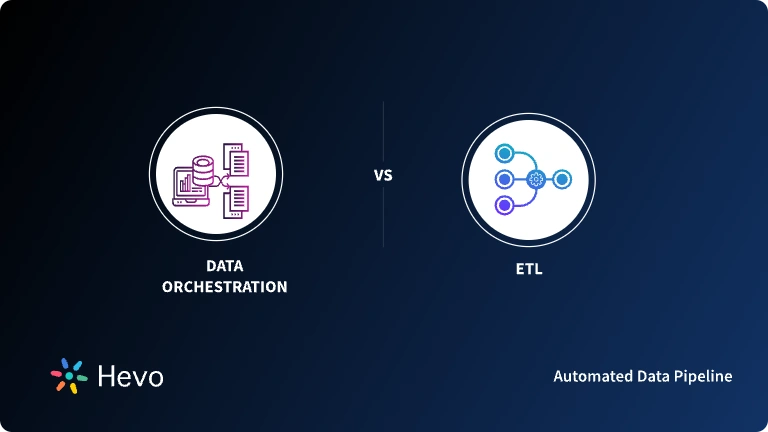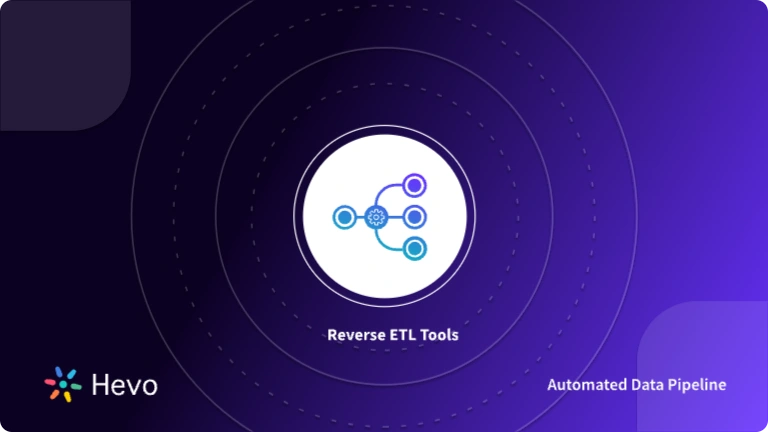Creating an ETL workflow is a time-consuming but critical component of the data warehousing process. The process of developing ETL workflow is frequently ad hoc, complicated, and based on trial-and-error.
It has been proposed that formal modeling of the ETL process can ease the majority of these problems. In general, employing structural patterns and best practices while building ETL operations may minimize implementation time and save money.
In this blog post, we’ll be discussing the build-up process for ETL Workflow. Let’s begin.
Streamline your ETL processes with Hevo’s no-code platform, which is designed to automate complex data workflows effortlessly. Our intuitive interface ensures smooth data extraction, transformation, and loading without the need for manual coding.
- Automate your ETL pipelines with ease.
- Enjoy flexible, real-time data transformations.
- Connect to 150+ data sources, including 60+ free sources
Join and trust Hevo to simplify ETL workflows. See why Hevo is rated 4.7 on Capterra for data integration excellence.
Table of Contents
Why is ETL Worth All the Rage?
Data-driven context plays an important role in framing decisions crucial for business success. I didn’t, but McKinsey did sure say that.
Let’s understand the above-given statement with an example. Suppose, there are two customers, A and B. Both customers require the availability of certain features, but if only limited engineering bandwidth is available, how do we decide which or how many features to prioritize?
To decide which customer to prioritize, historical data for both leads would matter a lot. For instance, if Customer A has subscribed previously to a more expensive plan but on the basis of the renewals database, we say they choose not to renew the subscription, but Customer B has renewed. Now, by comparing data, we would understand whether to again attempt to win over customer A or should instead prioritize customer B’s needs since we’re sure they will continue to use the product? The answer would definitely vary based on the organization’s priorities.
We can imagine how data can help build context through the above-given example, helping businesses become data-driven. And, this is where ETL comes in — working as a facilitator. ETL workflow helps deliver the needed context by helping teams understand data, and set workflow priorities based on the statistics they correspond to.
Altogether, there are some quantitative and qualitative benefits of using ETL too. Let’s list some of them now:
Improved Data Quality: ETL workflow enhances data quality by converting data from various databases, applications, and systems in order to fulfill internal and external compliance standards. Because all relevant data is cataloged for discovery, this consolidation gives historical context, reducing blind spots in decision making.
Improved Consistency: ETL facilitates analysis by converting data to conform to a standardized format. When all data is saved and searchable, ETL enhances the accuracy of computations and forecasts.
Enhanced Decision-Making Capabilities: ETL workflow speeds up decision-making by eliminating the need to query various data sources, each of which may have varied response times, in order to assemble a full picture.
Modeling ETL Workflows
ETL pipeline modeling is crucial for soo many obvious reasons. To begin with, modeling the ETL process aids in the design of an efficient, resilient, and evolvable ETL. It enables data warehouse teams to ask questions such as how good the current or proposed ETL workflow design is, whether the workflow is resilient to occasional failures, what parts of the workflow can be parallelized, whether there are any variants of the ETL workflow, and if so, which variant is better. Second, applying data modeling the ETL procedure is critical for optimizing data warehousing. When we talk about optimizing the ETL process, we are primarily concerned with a quick and efficient execution plan, which is the order of the ETL workflow activities.
At present, a few approaches to model ETL workflow exists. They are as follows:
Building an ETL Pipeline with Batch Processing
Data is processed in batches from source databases to a data warehouse in a standard ETL pipeline. Because creating an enterprise ETL workflow from Start is difficult, you often rely on ETL automation solutions like Hevo or Blendo to simplify and automate much of the process.
- Construct reference data: To create an ETL pipeline using batch processing, you must first create a dataset that outlines the range of possible values for your data. For example, in a nation data field, give the list of permitted country codes.
- Extract data from various sources: proper data extraction is the foundation for the success of following ETL workflow procedures. Convert data from many sources, such as APIs, non/relational databases, XML, JSON, and CSV files, into a single format for standardized processing.
- Validate the data: Keep any data that have values within the anticipated ranges and discard any that do not. If you just require dates from the last year, for example, reject any values older than 12 months. Ongoingly analyze rejected records to discover flaws, rectify the source data, and alter the extraction procedure to remedy the problem in future batches.
- Data transformation: It includes removing duplicate data (cleaning), applying business rules, ensuring data integrity (ensuring that data has not been altered or deleted), and creating aggregates as needed. If you wish to evaluate revenue, for example, you may aggregate the dollar amount of invoices into a daily or monthly total. To automatically convert the data, you must create a number of routines.
- Stage data: Typically, transformed data is not loaded immediately into the destination data warehouse. Instead, data is initially entered into a staging database, which allows for quicker rollback if something goes wrong. You may also produce audit reports for regulatory compliance or detect and remedy data errors at this stage.
- Publish to your data warehouse as follows: Load data into the desired tables. When the ETL pipeline loads a new batch of data into a data warehouse, it may overwrite previous data. This might happen daily, weekly, or monthly. In other circumstances, the ETL pipeline can add data without overwriting it, and it can include a date to indicate that it is new. You must proceed with caution to avoid the data warehouse “exploding” owing to disc space and performance constraints.
Building an ETL Pipeline with Stream Processing
Real-time data, such as web analytics data from a big e-commerce website, is frequently included in modern data processes. In these circumstances, instead of extracting and transforming data in huge batches, you must do ETL on data streams. As a result, as client applications send data to the data source, you must clean and alter it as it travels to the destination data storage.
Today, several stream processing solutions are available, such as Apache Samza, Apache Storm, and Apache Kafka. The figure below depicts a Confluent-described ETL pipeline based on Kafka:

To create a stream processing ETL pipeline using Kafka, you must first:
- Put data into Kafka: Confluent JDBC connector retrieves each row of the source table and publishes it as a key/value pair into a Kafka topic (a feed where records are stored and published). This subject is read by applications that are interested in the current status of this table. When client applications add rows to the source table, Kafka automatically uploads them to the Kafka topic as new messages, allowing a real-time data stream. It should be noted that you may create a database connection without using Confluent’s commercial solution.
- Extraction of data from Kafka topics: The ETL workflow program pulls messages from the Kafka topic as Avro records, prepares an Avro schema file, and deserializes them. The messages are then used to generate KStream objects.
- Transform data in KStream objects: the stream processor accepts one record at a time, processes it, and outputs one or more output records for downstream processors using the Kafka Streams API. These processors may modify messages one at a time, filter them depending on circumstances, and execute ETL data operations such as aggregation on many messages.
- Load data to other systems: The ETL workflow application still has the enhanced data and must now stream it into destination systems, such as a data warehouse or data lake. Confluent, for example, recommends utilizing their S3 Sink Connector to send data to Amazon S3. Using Amazon Kinesis, you can also interact with other systems, such as a Redshift data warehouse.
ETL VS ELT
| Aspect | ETL (Extract, Transform, Load) | ELT(Extract, Transform, Load) |
| Process Sequence | The transformation occurs before loading the data into the target system. | Data is loaded first, and the transformation happens afterward in the target system. |
| Data Volume | Suitable for smaller to medium datasets | Ideal for large datasets and big data environments |
| Processing Power | Relies on an ETL tool or server for transformations | Utilizes the processing power of the target system |
| Use Case | Traditional data integration and reporting | Big data and real-time analytics in cloud environments |
Why Build when you can buy — cheaper!
The quantity of data generated over the next three years will be more than the amount of data created during the previous 30 years. Furthermore, the globe is on track to generate more than three times as much data in the next five years as it did in the preceding five. This data tsunami has paved the way for significant expenditures in big data and advanced analytics programs. As a result, the decision to create domestically or acquire external technological solutions emerges.
Scalability and cost productivity are essential in today’s fast-paced business. The building provides freedom and ownership, whilst purchasing provides convenience and dependability. Maintaining a competitive advantage necessitates quick deployment times as well as necessary upgrades and new features. Furthermore, sophisticated technology partners such as Hevo Data provide the essential knowledge for data collecting, analysis, curation, and ETL workflow.
As more companies start to leverage pre-built ETL workflow products to get sharper and deeper analytical insights, current processes improve, and competitive and strategic advantage is gained. Simultaneously, rising sectors such as sustainable technology and cyber risk necessitate the development of new models to advise clients, insurers, and regulators. Again, the experience of product-led companies like Hevo Data is required to recognize these specific risk circumstances.
Learn More About:
Conclusion
Although these ETL modeling techniques were created for traditional relational databases (i.e. source dependent), they can also be used to model modern ETL workflows and data pipelines. But today, tools exist which can help you drastically. They will help you save time and engineering bandwidth so that they can focus on more crucial tasks. Enter Hevo!
Hevo Data, a No-code Data Pipeline can seamlessly transfer data from a vast sea of 150+ sources to a Data Warehouse or a Destination of your choice. It is a reliable, completely automated ETL, and secure service that doesn’t require you to write any ETL code!
If you are using CRMs, Sales, HR, and Marketing Applications and searching for a no-fuss alternative to Manual Data Integration, then Hevo can effortlessly automate this for you. Hevo, with its strong integration with 150+ sources (Including 60+ Free Sources), allows you to export, load, and transform data — and also make it analysis-ready in a jiffy!
FAQs
What is an ETL workflow?
An ETL (Extract, Transform, Load) workflow is the structured process through which data is collected from various sources, transformed into a suitable format, and then loaded into a target system, such as a database or data warehouse. The workflow defines the sequence of tasks and operations involved in the ETL process, ensuring that data is processed efficiently and accurately.
What are the 5 steps of the ETL process?
1. Data Extraction
2. Data Cleaning
3. Data Transformation
4. Data Loading
5. Validation & Monitoring
What is an example of an ETL flow?
Data is extracted from sources like sales databases and CRM systems, transformed by aggregating and standardizing information and loaded into a data warehouse. Validation ensures accuracy, and reporting tools generate insights to analyze sales trends, monitor inventory, and understand customer behavior.










